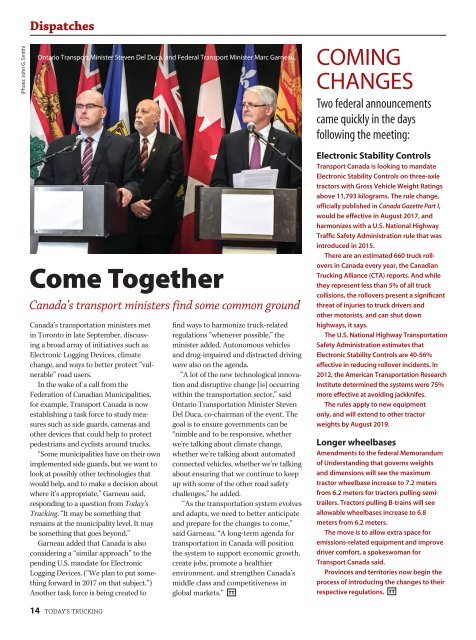DIGGING IN
2faRCNO
2faRCNO
You also want an ePaper? Increase the reach of your titles
YUMPU automatically turns print PDFs into web optimized ePapers that Google loves.
(Photo: John G. Smith)<br />
Dispatches<br />
Ontario Transport Minister Steven Del Duca, and Federal Transport Minister Marc Garneau.<br />
Come Together<br />
Canada’s transport ministers find some common ground<br />
Canada’s transportation ministers met<br />
in Toronto in late September, discussing<br />
a broad array of initiatives such as<br />
Electronic Logging Devices, climate<br />
change, and ways to better protect “vulnerable”<br />
road users.<br />
In the wake of a call from the<br />
Federation of Canadian Municipalities,<br />
for example, Transport Canada is now<br />
establishing a task force to study measures<br />
such as side guards, cameras and<br />
other devices that could help to protect<br />
pedestrians and cyclists around trucks.<br />
“Some municipalities have on their own<br />
implemented side guards, but we want to<br />
look at possibly other technologies that<br />
would help, and to make a decision about<br />
where it’s appropriate,” Garneau said,<br />
responding to a question from Today’s<br />
Trucking. “It may be something that<br />
remains at the municipality level. It may<br />
be something that goes beyond.”<br />
Garneau added that Canada is also<br />
considering a “similar approach” to the<br />
pending U.S. mandate for Electronic<br />
Logging Devices. (“We plan to put something<br />
forward in 2017 on that subject.”)<br />
Another task force is being created to<br />
find ways to harmonize truck-related<br />
regulations “whenever possible,” the<br />
minister added. Autonomous vehicles<br />
and drug-impaired and distracted driving<br />
were also on the agenda.<br />
“A lot of the new technological innovation<br />
and disruptive change [is] occurring<br />
within the transportation sector,” said<br />
Ontario Transportation Minister Steven<br />
Del Duca, co-chairman of the event. The<br />
goal is to ensure governments can be<br />
“nimble and to be responsive, whether<br />
we’re talking about climate change,<br />
whether we’re talking about automated<br />
connected vehicles, whether we’re talking<br />
about ensuring that we continue to keep<br />
up with some of the other road safety<br />
challenges,” he added.<br />
“As the transportation system evolves<br />
and adapts, we need to better anticipate<br />
and prepare for the changes to come,”<br />
said Garneau. “A long-term agenda for<br />
transportation in Canada will position<br />
the system to support economic growth,<br />
create jobs, promote a healthier<br />
environment, and strengthen Canada’s<br />
middle class and competitiveness in<br />
global markets.” TT<br />
COM<strong>IN</strong>G<br />
CHANGES<br />
Two federal announcements<br />
came quickly in the days<br />
following the meeting:<br />
Electronic Stability Controls<br />
Transport Canada is looking to mandate<br />
Electronic Stability Controls on three-axle<br />
tractors with Gross Vehicle Weight Ratings<br />
above 11,793 kilograms. The rule change,<br />
officially published in Canada Gazette Part I,<br />
would be effective in August 2017, and<br />
harmonizes with a U.S. National Highway<br />
Traffic Safety Administration rule that was<br />
introduced in 2015.<br />
There are an estimated 660 truck rollovers<br />
in Canada every year, the Canadian<br />
Trucking Alliance (CTA) reports. And while<br />
they represent less than 5% of all truck<br />
collisions, the rollovers present a significant<br />
threat of injuries to truck drivers and<br />
other motorists, and can shut down<br />
highways, it says.<br />
The U.S. National Highway Transportation<br />
Safety Administration estimates that<br />
Electronic Stability Controls are 40-56%<br />
effective in reducing rollover incidents. In<br />
2012, the American Transportation Research<br />
Institute determined the systems were 75%<br />
more effective at avoiding jackknifes.<br />
The rules apply to new equipment<br />
only, and will extend to other tractor<br />
weights by August 2019.<br />
Longer wheelbases<br />
Amendments to the federal Memorandum<br />
of Understanding that governs weights<br />
and dimensions will see the maximum<br />
tractor wheelbase increase to 7.2 meters<br />
from 6.2 meters for tractors pulling semitrailers.<br />
Tractors pulling B-trains will see<br />
allowable wheelbases increase to 6.8<br />
meters from 6.2 meters.<br />
The move is to allow extra space for<br />
emissions-related equipment and improve<br />
driver comfort, a spokeswoman for<br />
Transport Canada said.<br />
Provinces and territories now begin the<br />
process of introducing the changes to their<br />
respective regulations. TT<br />
14 TODAY’S TRUCK<strong>IN</strong>G


